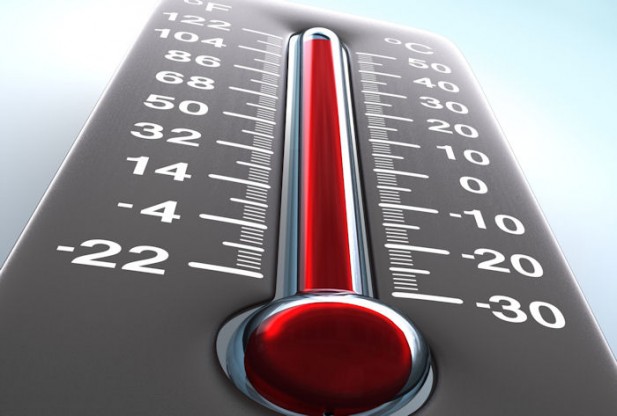
A cooling tower primarily uses latent heat of vaporization (evaporation) to cool process water. Minor additional cooling is provided by the air because of its temperature increase. Cooling tower selection and performance is based on water flow rate, water inlet temperature, water outlet temperature, and ambient wet bulb temperature. The temperature difference between the inlet and outlet is called the cooling tower water temperature range. Ambient wet bulb temperature and its effect on performance is the subject of this article.
Ambient wet bulb temperature is a condition measured by a device called a psychrometer. A psychrometer places a thin film of water on the bulb of the thermometer that is twirled in the air. After about a minute, the thermometer will show a reduced temperature. The low point when no additional twirling reduces the temperature is called the wet bulb temperature. The measured wet bulb is a function of relative humidity and ambient air temperature. Wet bulb temperature essentially measures how much water vapor the atmosphere can hold at current weather conditions. A lower wet bulb temperature means the air is drier and can hold more water vapor than it can at a higher wet bulb temperature.
| Dry Bulb Temperature | % Relative Humidity | Resultant Wet Bulb Temperature |
|---|---|---|
| 50°F | 40%> | 40°F |
| 60°F | 50%> | 50°F |
| 70°F | 35%> | 55°F |
| 85°F | 55%> | 73°F |
| 90°F | 60%> | 78°F |
Since cooling tower cells cool water by evaporation, the wet bulb temperature is the critical design variable. An evaporative cooling tower can generally provide cooling water 5°F-7°F higher above the current ambient wet bulb condition. That means that if the wet bulb temperature is 78°F, then the cooling tower will most likely provide cooling water between 83°F- 85°F, no lower. The same tower cell, on a day when the wet bulb temperature is 68°F, is likely to provide 74°F-76°F cooling water. When selecting a cooling tower cell, the highest wet bulb temperature in your geographical area must be used. Highest wet bulb temperatures occur during the summer, when air temperatures and humidity are highest.
In Indianapolis, Indiana, the design wet bulb temperature is 78°F. Historically, Indianapolis can expect less than one hour per year when the conditions exceed a 78°F wet bulb. Typically, 6,000 hours a year will have a wet bulb of 60°F or lower, meaning that a cooling tower cell designed for a 78°F wet bulb will be able to make 65°F -67°F water for 6,000 hours per year nearly 70% of the year. Most cooling towers are capacity rated at a "standard" wet bulb temperature of 78°F. That means on the days when the wet bulb temperature is 78°F, the tower will produce its stated capacity. In other words, a tower rated to produce 135 tons of cooling will produce 135 tons of cooling at a 78°F wet bulb temperature. At a higher wet bulb temperature, the tower cell capacity to produce colder water decreases. Every location has a unique design (worst case) wet bulb temperature that is published by organizations such as ASHRAE and can be obtained easily. Wet Bulb Temperatures for Evaporative Cooling Equipment.
What Does It Mean When Your Cooling Tower Temperature Is Higher than Normal?
Industrial cooling tower performance is tied to ambient wet bulb conditions. Higher wet bulb temperatures occur in the summer when higher ambient and relative humidity occurs. Initial system design and proper system maintenance are critical to be certain your cooling tower is providing the desired cooling. Wet Bulb Temperatures for Evaporative Cooling Equipment.
Delta, the technology-leading cooling tower manufacturer in the US, is here to help. At Delta, we go above the standards of other manufacturers to provide a 20-year warranty, so you do not have to worry about replacements. Delta’s high-quality cooling towers offer customers not only an extended lifecycle but also fewer parts and, therefore, less maintenance downtime. Click here to get your quote today!
From our low maintenance design to our manufacturing process to excellent customer service, we're sure you'll be pleased with our superior cooling towers, every step of the way. Get a quote